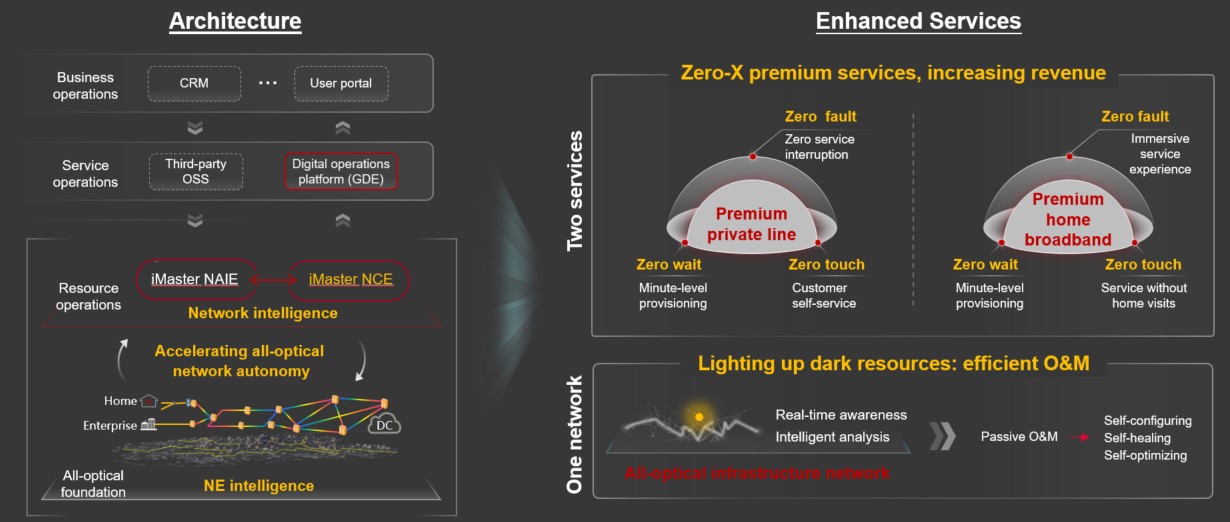Zero-X Autonomy: The Future of Optical Network Management
The annual Next Generation Optical Network Forum (NGON) took place on November 15-19. Dr. Christopher Janz, Vice President of Huawei Canada Optical Systems Competence Center, delivered a keynote speech entitled “Optical Autonomous Network”.
Huawei also published the technical white paper ACTN 2.0 at the time of the event.
Improving network O&M efficiency and building high-quality connections closer to service delivery is gaining momentum in the industry. As an efficient, secure, and green solution, all-optical autonomous driving networks help operators improve intelligence in planning, network construction, and O&M, promoting high-quality development of all-optical services.
With the rapid development of digitalization, cloud services, and 5G services, optical network management and control systems are facing greater challenges.
1) The scale, dynamics, and complexity of networks have increased, and existing management systems cannot meet the new challenges.
2) With the emergence of new applications, the requirements for service experience and network reliability are increasing, and the requirements for personalized management are also increasing. These changes are driving a continuous enhancement of carrier services, driving the evolution of optical networks to automation and intelligence, and gradually to all-optical autonomous networks.

Huawei’s autonomous driving network solution is aligned with TM Forum‘s autonomous network concepts. By collecting and analyzing data, the Huawei solution guides network decision-making and execution during the network planning, construction, maintenance, optimization, and operation phases. It thus provides more agile network operations, reduces OPEX, and provides more diversified services for users.
Improved User Experience
Based on the physical characteristics of optical networks, the industry has extensively researched tools and applications such as advanced optical performance monitoring, traffic prediction, risk prediction, and alarm filtering. Research achievements have led to two changes in management and control technologies in the industry.
1) Intelligence is introduced to the NE and network layers of optical networks to underpin single-domain autonomy of all-optical networks.
2) Optical network service capabilities are fully opened to achieve cross-technology collaboration and business-driven closed-loop alignment between service needs and delivery.
We are after significant benefits and impacts related to service innovation and enhancement, including the facilitation of service scale and complexity, an improvement in service quality of experience, and the enablement of service mass-customization and dynamic user control.

All-optical networks provide users with optimal network service experiences. With the upgrade of enterprise leased line and home broadband services, high-quality OTN leased line and home broadband services are becoming new growth points for optical networks. The emergence of autonomous technologies enables operators to achieve agile provisioning, providing zero-wait services for users. Intelligent technologies provide root cause analysis to accurately identify major network problems and implement zero-touch maintenance. During service upgrades and network faults, intelligent technologies can accurately locate and quickly provide high-quality resources for service switchover, achieving zero-fault experience throughout the lifecycle.
A Strong Sense of Self
From the perspective of network O&M, all-optical autonomous driving networks can greatly improve operators’ O&M experiences. Self-configuration technology implements automatic management on network devices and automatic service provisioning, ensuring uninterrupted service upgrades. Self-healing technology enables fast network fault identification, accurate diagnosis and location, and self-healing without affecting user and O&M experience. Self-optimization technology optimizes resource configuration based on specific scenarios, achieving more efficient network resource utilization.
Zero-X
A new class of premium customer services that we call “Zero-X”, for zero-touch, zero-wait and zero-fault, represents significant service and revenue impacts of major advances toward optical network autonomy.
With the joint efforts of operators and equipment vendors, the management and operation of optical networks are evolving towards the common goal of automation and autonomy.
International standards organizations, such as TM Forum, ETSI, and IETF, have carried out related research and standardization work and released standards touching on architecture, key technologies, best practices, and data models to promote autonomous network management. With the commercial deployment of SDN, advanced optical performance monitoring and automatic management technologies are becoming widely used in networks, and self-configuration and self-monitoring features have become a reality.
In the next few years, the industry will focus on analysis, diagnosis, and prediction to further improve the intelligence level of optical networks throughout their lifecycle to reach the TM Forum-defined “Level 4” by 2025.
ACTN 2.0
ACTN 2.0 is our term for the continuing standard work in IETF, with more applications and data models driving optical network control and management toward the future autonomous network.
The physical characteristics and networking complexity of all-optical networks make the march toward fully autonomous all-optical autonomous driving networks a long-term process. Huawei looks forward to working with carrier partners, standards organizations, research institutes, and ecosystem partners. We have continuously explored and developed key technologies and innovative applications in all dimensions of all-optical network planning, construction, maintenance, optimization, and operation, bringing quality connectivity to every home and enterprise, and facilitating the high-quality development of the digital economy.
We expect increasing intelligence and automation to have impacted most areas of optical network operations by the second half of this decade.
Download the Huawei ACTN 2.0 white paper.
Disclaimer: Any views and/or opinions expressed in this post by individual authors or contributors are their personal views and/or opinions and do not necessarily reflect the views and/or opinions of Huawei Technologies.
Leave a Comment